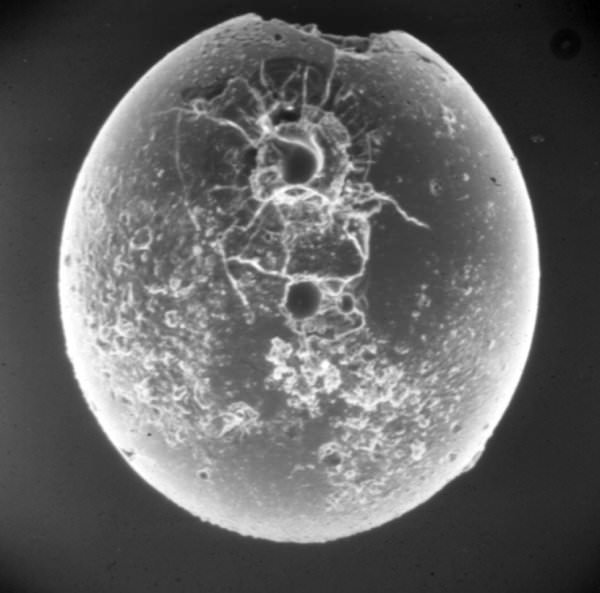Here’s this week’s image for the WITU Challenge, to test your visual knowledge of the cosmos. You know what to do: take a look at this image and see if you can determine where in the universe this image is from; give yourself extra points if you can name the spacecraft responsible for the image. We’ll provide the image today, but won’t reveal the answer until tomorrow. This gives you a chance to mull over the image and provide your answer/guess in the comment section. Please, no links or extensive explanations of what you think this is — give everyone the chance to guess.
If you need some more challenges, look back at all previous 61 Where In the Universe Challenges.
UPDATE: The answer has now been posted below
This the is Apollo 11 anniversary edition of WITU!
This is a microscopic look at one of the Moon rocks returned by the Apollo astronauts. It shows a glass spherule (about 0.6 mm in diameter) produced by a meteorite impact into lunar soil. Features on the surface are glass splashes, welded mineral fragments, and microcraters produced by space weathering processes at the surface of the moon.
The astronauts brought back 841 pounds of rocks from the lunar surface, and scientists say the rocks are completely unique and couldn’t have come from Earth. There is little or no water in these rocks, plus they are peppered with tiny micrometeorite hits, as seen on this sample. This could only happen to rocks from a planet with little or no atmosphere… like the Moon.
Enjoy the Apollo 11 anniversary hubbub and come back next week for another WITU challenge!


Earth. This is an electron-microscope image of some kind of micro-pebble.
A good choice, though. I’m sure it’ll fool plenty of people. 😉
And I now know with absolute certainty what this is. I should have checked tweeter before answering. 😉
I call pollen.
It’s a tiny (glass?) bead from one of the Apollo missions, from lunar soil; the holes/craters are from micro (nano?) meteorite impacts.
This is a glass bead from either a pyroclastic flow of a terrestrial volcano, or it is from lunar dust.
Since several people have already said what I believe it to be, I will venture to say that it is planet X coming to get us on Dec 21, 2012. The missing chunk is from a previous brush against the Earth that caused the formation of the moon.
Electron microscope image of lunar dust.
Well it’s not a photo of an orbiting body but a micrograph of something small. The impact fracture lines show it has a glassy nature and the spheroidal shape suggests that it has melted. It could be man made but let’s go for a lunar soil sample, itself bombarded by micro-meteorittes. It might even be some of the ‘orange soil’ collected by Harrison Schmitt on Apollo 17. In due of the date though, let’s go for some of Neil Armstrong’s haul from the Sea of Tranquility.
It is definitely a TEM image.. But i would go with those particles which are collected from Genesis…..
Microsphere from lunar soil.
It looks like a Scanning Electron Microscope (SEM) image. Transmission electron microscope (TEM) images look very different. I have driven both.
We are asked for the ‘spacecraft responsible’ for the image, which I guess must mean the spacecraft that bought whatever it is (my guess is a bead of something glassy). However, it does beg the question why we don’t have SEM probes on, say, the Martian landers.
A scanning electron microscope us normally a great, bench-sized thing with vacuum pumps and high voltage. However, there is lots of vacuum in space, and on Mars an electron beam could travel for an inch or so. The main column will still have to be evacuated, but you can do this with a turbomolecular pump without the backing pump you need for earth-bound instruments. Collecting the secondary electrons, which are what actually makes the image, gets trickier, but it is possible: there are differentially pumped instruments on earth that look at living material under atmospheric conditions. If you restrict your beam to a few tens of kilovolts, and don’t go for the highest magnification, then there is lots you can see.
Normally, electron microscope subjects are coated in gold, so charge does not build up. However, you can look at uncoated stuff. I have looked at foams and other stuff. They can spark and fly to bits, and contaminate your column, but go carefully and you can get away with a lot.
Once you can stick electron beams at your rocks, there is lots of other stuff you can look for, such as X-rays. I don’t think this image has come from a spacecraft (unless they have one on the ISS). But I think they should do, one day.
A photomicrograph of a tiny glass bead with some micro-meteorite craters. The craters would eliminate an earthly origin. That makes it either moon, comet or space dust. I’ll hazard space dust gathered from a high altitude sampling of the upper atmosphere.
A micrometeorite impact on a section of shuttle hull.
I believe this to be an electron microscope image of a micro or nano meteor found on earth, more specifically, in the arctic or antarctic. Definatly dont think its moon dust. I recall an article on the discovery of these on one of the poles.
😀
MM40 a achondritic basaltic micrometeorite.
glass beads from the moon with micrometeorite impacts
They must be TARDIGRADES, some very small but incredibly resistant bugs.
It’s a glass spherule produced by a meteorite impact into lunar soil. The Apollo mission is indirectly involved on this image.
Alternately it’s the Death Star… one slightly careless owner! 😉
An electron microscope image of a ~ 500 micrometre meteor found on the north or south pole of earth.